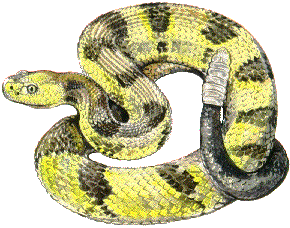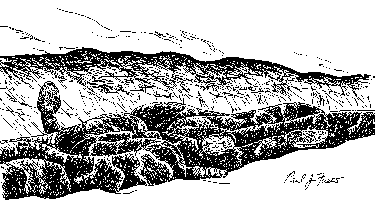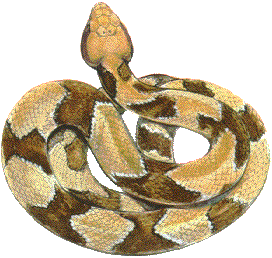

|
| TIMBER RATTLESNAKE Crotalus horridus |
E N D A N G E R E D |
 |
E N D A N G E R E D |
| Habitat: Deciduous forests
(often second growth) in rugged terrain with steep ledges, rock slides and a nearby water
supply. Size: Adults average 38-43 inches in length. Life Expectancy: 30 years in captivity. |
Food: Primarily mice, other
small mammals, like voles, shrews, chipmunks and squirrels, and occasionally birds. Status: State endangered. |
Identification: The timber rattlesnake and the copperhead are the only venomous snakes found in Connecticut. Rattlesnakes can usually be identified by the distinctive rattle at the tip of the tail. Other distinguishing characteristics include vertical eye pupils, a flattened, unmarked, triangular head about twice the size of the neck, and undivided scales on the underside between the vent and the tip of the tail.
The timber rattlesnake is a heavy-bodied snake that occurs in 2 color variations in Connecticut. The yellow variation has black or brown crossbands on a yellow, brown or gray background. The crossbands, which may be V-shaped, break up toward the head to form a row of dark spots down the back and each side. The dark variation has a heavy speckling of black or very dark brown that hides much of the lighter pigment. Both sexes are similar, although the males have longer tails (not rattles).
Range: Timber rattlesnakes range from southern New Hampshire, west through the Champlain Valley, south through the Appalachian and Blue Ridge Mountains, into northeastern Texas and north along the Mississippi River to Wisconsin.
Reproduction: Timber rattlesnakes breed in either the spring or fall and give birth to an average of 9 young in August to late September. The young snakes are born live in a membranous sac which they open with a sharp egg tooth. The 8 to 10-inch long young are equipped with a single, tiny rattle segment (button), venom and fangs; they receive no maternal care. Timber rattlesnakes reach sexual maturity between 7 to 10 years of age. Females breed every third or fourth year.
Reason for Decline: Indiscriminate killing, illegal collection and loss of habitat due to human development have resulted in the severe decline of timber rattlesnake populations. The species has been eliminated from many parts of its historic range. Disturbance by humans and lack of suitable den sites appear to be the major limiting factors for rattlesnakes in Connecticut.
History in Connecticut: The timber rattlesnake was probably very widespread in colonial times, as evidenced by the many land features named "rattlesnake." In the past, some Connecticut towns had bounties on rattlesnakes, and many of the dens were repeatedly decimated. Once documented in over 20 towns in Connecticut, this snake is now limited to isolated populations in 10 towns.
Interesting Facts: As a member of the "pit viper" family, the timber rattlesnake has facial pits located on each side of its head between the eye and nostril. These pits are sensitive to radiant heat and help the snake detect warm-blooded prey in the darkness. Non-venomous snakes do not have these heat-sensitive pits.
Snakes have poor eyesight; their vision is limited to detecting motion at short distances. Their sense of smell is highly developed. Snakes flick their modified forked tongue in the air, collecting scent particles. They have no ears but can detect vibrations in the ground to determine the size of passing animals, the animals’ direction and distance from the snake. The rattle is an important warning device. Black rat snakes, milk snakes and others mimic a rattling noise by vibrating their tail in dry leaves.
Rattlesnakes have 2 hollow fangs, which are connected to a venom gland and located in the front of the mouth. They are shed periodically and replaced. The primary purpose of venom is to immobilize prey and to aid in digestion. Venom in snakes is not a defensive adaptation. Defensive bites may carry only a fraction of the venom injected in prey.
During the winter months, groups of timber rattlesnakes hibernate together underground in dens in rocky ledges. Many other species of snakes may hibernate in the same den. In mid-April, the rattlesnakes emerge from their dens to bask on the ledges during the day. In May and June, the snakes begin to migrate in a pattern which, by fall, will bring them back to the den. Breeding can occur only in the spring and fall when the males and receptive females are in the same area. The snakes probably travel between 1.3 and 2.5 miles from the den during this seasonal cycle.
In Connecticut, rattlesnake bites are rare. If a bite occurs, medical attention should be sought as soon as possible. The victim should remain calm; an increased heart rate will speed up the spread of venom. The traditional snake bite treatment of a tourniquet and sucking out of the venom is not recommended.
Timber rattlesnakes are secretive by nature. They usually detect approaching humans and move away to hide. If a sleeping rattlesnake is encountered, it may recoil into a defensive posture and rattle. When this situation occurs, the best solution is to back away slowly. Snake vision is designed to detect motion; quick movements may further agitate the snake.
Protective Legislation: State - Connecticut General Statutes Sec. 26-311.
What You Can Do: In areas of the state where timber rattlesnakes still exist, intensive land development can place humans in the species’ migratory path. Use of yards by snakes can be discouraged by removing hiding places. Keep grass cut short and remove brush piles and stone walls. Be careful where pets are allowed to roam. Usually, human presence is sufficient enough to drive off a snake. If a snake persists, assistance is available. Contact the Wildlife Division at 642-7239 or DEP Communications at 566-3333 to find out about volunteers in your area who are qualified to handle venomous snakes. Do not attempt to remove timber rattlesnakes on your own; they can be aggressive when handled.
Timber rattlesnakes are protected by Connecticut's threatened and endangered species legislation and cannot be killed. If you observe anyone killing a rattlesnake, report the violation to the state TIP (Turn in Poachers) Program at 1-800-842-HELP. The Wildlife Division appreciates your help in conserving this important species and welcomes sighting reports and other information you may have.
Connecticut Range |
|



The copperhead is a poisonous snake with a broad triangular head, vertically elliptical pupils and a heat sensitive pit between each eye and nostril. The body is pinkish to grayish brown with brown or reddish-brown crossbands that are narrow on the back and widest on the sides. Small dark spots commonly occur between crossbands on the back. The unpatterned head is dull orange, copper or rusty-red. Body scales are keeled and the belly is pink or light brown with dark blotches along the sides. When young, a copperhead has a yellow-tipped tail.
Mating takes place in spring and fall and females give birth to 4-8 young in August and September. Adult females usually give birth every two years.
Copperheads prefer rocky, forested hillsides and wetlands for habitat. Wet areas are particularly sought out in the hot summer months. Small mammals and frogs account for most of the prey items taken, but birds, insects and other snakes are also important parts of their diets. When approached, they will either move away quietly or lay motionless, relying on camouflage to protect them. Occasionally, they will vibrate their tails. Bites usually occur when people unknowingly step on or touch unseen snakes. Despite the poisonous nature of copperhead bites, they are rarely fatal. In Connecticut, copperheads are so rare and reclusive that most people almost never encounter them.
